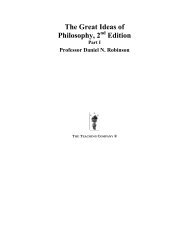English idioms in the first language and second language lexicon: a ...
English idioms in the first language and second language lexicon: a ...
English idioms in the first language and second language lexicon: a ...
Create successful ePaper yourself
Turn your PDF publications into a flip-book with our unique Google optimized e-Paper software.
Beate Abel 3491996b; 1997). Therefore, <strong>the</strong> same factors should account for <strong>the</strong>irspecific representations.The differences described <strong>in</strong> <strong>the</strong> fourth assumption have beenempirically supported. In Studies 1 <strong>and</strong> 2, nonnatives showed ageneral tendency to judge <strong>idioms</strong> as be<strong>in</strong>g decomposable, whereasnatives more often judged <strong>the</strong>m as be<strong>in</strong>g nondecomposable.Nonnatives who read <strong>English</strong> texts daily <strong>and</strong> thus come across<strong>idioms</strong> more frequently, which leads to <strong>the</strong> development of idiomentries, start to judge <strong>idioms</strong> as nondecomposable, just as nativesdo. Fur<strong>the</strong>rmore, <strong>the</strong> fourth assumption is supported by statementsgiven by <strong>the</strong> nonnative participants. In <strong>the</strong> biographicalquestionnaire, <strong>the</strong>y were asked what <strong>the</strong>y do if <strong>the</strong>y encounter anunknown idiom <strong>in</strong> an <strong>English</strong> text. The majority answered that <strong>the</strong>yconsider <strong>the</strong> literal mean<strong>in</strong>g of <strong>the</strong> constituents <strong>and</strong> <strong>the</strong>n try to puttoge<strong>the</strong>r <strong>the</strong> idiomatic mean<strong>in</strong>g of <strong>the</strong> whole phrase. In this process,contextual <strong>and</strong> conceptual factors play an important role. Theseutterances show that nonnatives actually ‘decompose’, whereasnatives do not have to consider <strong>the</strong> constituent mean<strong>in</strong>g, because<strong>the</strong>y activate <strong>the</strong>ir exist<strong>in</strong>g idiom entry. In terms of Giora’s gradedsalience hypo<strong>the</strong>sis (Giora, 1997; 1999; Giora <strong>and</strong> Fe<strong>in</strong>, 1999) thiscan be <strong>in</strong>terpreted as a difference <strong>in</strong> salience for <strong>the</strong> two groups.Giora (1999: 919) assumes that ‘<strong>the</strong> salient mean<strong>in</strong>g of a word oran expression is its lexicalized mean<strong>in</strong>g, i.e., <strong>the</strong> mean<strong>in</strong>g retrievablefrom <strong>the</strong> mental <strong>lexicon</strong> ra<strong>the</strong>r than from <strong>the</strong> context’. This<strong>in</strong>dicates that for natives, <strong>the</strong> figurative mean<strong>in</strong>g of an idiom ishighly salient, which is reflected <strong>in</strong> <strong>the</strong> existence of an idiom entry,whereas for nonnatives it is less salient <strong>and</strong> leads <strong>the</strong>m to activate<strong>the</strong>ir constituent entries. 10The DIR Model makes more assumptions than <strong>the</strong> four discussedabove (see Abel, 2003). For example, it considers <strong>the</strong> generalorganization <strong>and</strong> structure of <strong>the</strong> <strong>lexicon</strong>. In accordance withTabossi <strong>and</strong> Zardon (1993), it is assumed that access to <strong>the</strong> idiomentry is only possible after <strong>the</strong> <strong>first</strong> constituent entry has beenactivated. Fur<strong>the</strong>rmore it postulates that lexical redundancy rules(Jackendoff, 1975) l<strong>in</strong>k <strong>the</strong> constituent <strong>and</strong> idiom entries <strong>and</strong> thatfor decomposable <strong>idioms</strong> <strong>the</strong> semantic l<strong>in</strong>ks between <strong>the</strong> variouslexical entries are stronger than <strong>in</strong> <strong>the</strong> case of nondecomposable10The compatibility between <strong>the</strong> model suggested here <strong>and</strong> Giora’s graded saliencehypo<strong>the</strong>sis is due to <strong>the</strong> factors that <strong>in</strong>fluence decomposability <strong>and</strong> salience. Giora (1997:185) states that ‘[t]he salience of a word or an utterance is a function of its conventionality. . ., familiarity . . ., frequency . . ., or givenness status <strong>in</strong> a certa<strong>in</strong> (l<strong>in</strong>guistic or nonl<strong>in</strong>guistic)context.’ As has been argued here, <strong>the</strong>se factors determ<strong>in</strong>e judgements aboutdecomposability as well (for a similar approach, see Titone <strong>and</strong> Conn<strong>in</strong>e, 1999).Downloaded from http://slr.sagepub.com at Shanghai Jiaotong University on March 7, 2009














